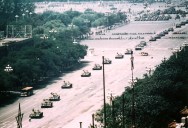The Bigger Picture: Uncropped Versions of Iconic Photos
by twistedsifter
A recent post on MetaFilter (that was subsequently picked up by PetaPixel), shows a handful of uncropped versions of iconic images from the last century.
From politics and war to sports and music, this small collection of images are a fascinating look back in history. Many thanks to Bora Horza Gobuchul on Metafiler and PetaPixel (along with the helpful commenters in each) for the compiling.
Tank Man – Tiananmen Square June 5, 1989

Tank Man, or the Unknown Rebel, is the nickname of an anonymous man who stood in front of a column of Chinese Type 59 tanks the morning after the Chinese military forcibly removed protestors from in and around Beijing’s Tiananmen Square on June 5, 1989. The man achieved widespread international recognition due to the videotape and photographs taken of the incident. Despite his anonymity, he is commonly (though not necessarily correctly) referred to in Chinese as Wang Weilin, as dubbed by a Sunday Express article. [Source: Wikipedia]
Guerrillero Heroico by Alberto Korda
Che Guevara March 5, 1960
Guerrillero Heroico (English: “Heroic Guerrilla Fighter”) is an iconic photo of Marxist revolutionary Che Guevara wearing his black beret taken by Alberto Korda. It was taken on March 5, 1960, in Havana, Cuba, at a memorial service for victims of the La Coubre explosion and by the end of the 1960s turned the charismatic and controversial leader into a cultural icon. Korda has said that at the moment he shot the picture, he was drawn to Guevara’s facial expression, which showed “absolute implacability” as well as anger and pain. Years later, Korda would say that the photo showed Che’s firm and stoic character. Guevara was 31 at the time the photo was taken.
As a life-long communist and supporter of the Cuban Revolution until his death, Alberto Korda claimed no payment for his picture. A modified version of the portrait through the decades was also reproduced on a range of different media, though Korda never asked for royalties. Korda reasoned that Che’s image represented his revolutionary ideals, and thus the more his picture spread the greater the chance Che’s ideals would spread as well. Korda’s refusal to seek royalties for the vast circulation of his photograph “helped it become the ultimate symbol of Marxist revolution and anti-imperialist struggle.” [Source: Wikipedia]
Million Dollar Quartet – Memphis, Tennessee December 4, 1956


“Million Dollar Quartet” is the name given to recordings made on Tuesday December 4, 1956 in the Sun Record Studios in Memphis, Tennessee. The recordings were of an impromptu jam session among Elvis Presley, Jerry Lee Lewis, Carl Perkins, and Johnny Cash. Marilyn Knowles-Riehl is the mystery woman seated on the piano in the Million Dollar Quartet photo from 1956. She was Elvis’ girlfriend at the time and was there in Sun Studios at the legendary 1956 jam session. In fact, her voice is heard on the historic recording. [Source: ElvisNews.com]
Ty Cobb Steals Third by Charles Conlon
Hilltop Park July 23, 1910


Charles Martin Conlon (November, 1868 – 1945) was an American photographer. He worked for New York City newspapers in the early 1900s, as a proof-reader with a photographic hobby before editor John B. Foster invited him to shoot photographs for The Telegram daily newspaper sporting pages and for the Spalding’s Base Ball Guide annual.
Charley Conlon took thousands of portraits of major league baseball players. His most famous photo is a fortunate action shot of Ty Cobb sliding into third base at Hilltop Park on July 23, 1910, upending the fielder, Jimmy Austin. Conlon was actually on the field, a common practice of the day, behind third base, under the hood of a large, tripod-supported Graflex camera. He was positioned to the outfield side of the third base coach’s box, in foul territory. [Source: Wikipedia]
Loch Ness Monster – “The Surgeon’s Photograph” April 21, 1934


The “Surgeon’s Photograph” purported to be the first photo of a “head and neck” of the Loch Ness Monther. Dr. Wilson claimed he was looking at the loch when he saw the monster, so grabbed his camera and snapped five photos. After the film was developed, only two exposures were clear. The first photo (the more publicised one) shows what was claimed to be a small head and back. The second one, a blurry image, attracted little publicity because it was difficult to interpret what was depicted.
The image was revealed as a fake in The Sunday Telegraph dated 7 December 1975. Supposedly taken by Robert Kenneth Wilson, a London gynaecologist, it was published in the Daily Mail on 21 April 1934. Wilson’s refusal to have his name associated with the photograph led to it being called “Surgeon’s Photograph”. [Source: Wikipedia]
Sgt. Pepper Album Cover Shoot – Unused Hitler Cutout 1967


This is a rare photograph that’s more of a behind-the-scenes than uncropped picture. It’s a studio shot from the making of the Sgt. Pepper’s Lonely Hearts Club Band album cover. Often shortened to Sgt. Pepper, it was The Beatles eigth studio album.
The Grammy Award-winning album packaging was art-directed by Robert Fraser, designed by Peter Blake and Jann Haworth, his wife and artistic partner, and photographed by Michael Cooper. It featured a colourful collage of life-sized cardboard models of famous people on the front of the album cover and lyrics printed on the back cover, the first time this had been done on a British pop LP. The Beatles themselves, in the guise of the Sgt. Pepper band, were dressed in custom-made military-style outfits made of satin dyed in day-glo colours.
The collage depicted more than 70 famous people, including writers, musicians, film stars, and (at Harrison’s request) a number of Indian gurus. The final grouping included Marlene Dietrich, Carl Gustav Jung, W.C. Fields, Diana Dors, James Dean, Bob Dylan, Issy Bonn, Marilyn Monroe, Aldous Huxley, Karlheinz Stockhausen, Sigmund Freud, Aleister Crowley, Edgar Allan Poe, Karl Marx, Oscar Wilde, William S. Burroughs, Marlon Brando, Stan Laurel and Oliver Hardy, and controversial comedian Lenny Bruce. Also included was the image of the original Beatles’ bassist, the late Stuart Sutcliffe. Adolf Hitler and Jesus Christ were requested by Lennon, but ultimately they were left out. [Source: Wikipedia]
See here for a complete list of people on the album cover.
Raising the Flag on Iwo Jima by Joe Rosenthal
Mount Suribachi February 23, 1945


Raising the Flag on Iwo Jima is an historic photograph taken on February 23, 1945, by Joe Rosenthal. It depicts five United States Marines and a U.S. Navy corpsman raising the flag of the United States atop Mount Suribachi during the Battle of Iwo Jima in World War II.
It became the only photograph to win the Pulitzer Prize for Photography in the same year as its publication, and came to be regarded in the United States as one of the most significant and recognizable images of the war, and one of the most reproduced photograph of all time. Of the six men depicted in the picture, three (Franklin Sousley, Harlon Block, and Michael Strank) were killed during the battle; the three survivors (John Bradley, Rene Gagnon, and Ira Hayes) became celebrities upon their identification in the photo. The picture was later used by Felix de Weldon to sculpt the Marine Corps War Memorial, located adjacent to Arlington National Cemetery just outside Washington, D.C. [Source: Wikipedia]
If you enjoyed this post, the Sifter highly recommends:
Categories: BEST OF, HISTORY, STORIES
Tags: · controversial




